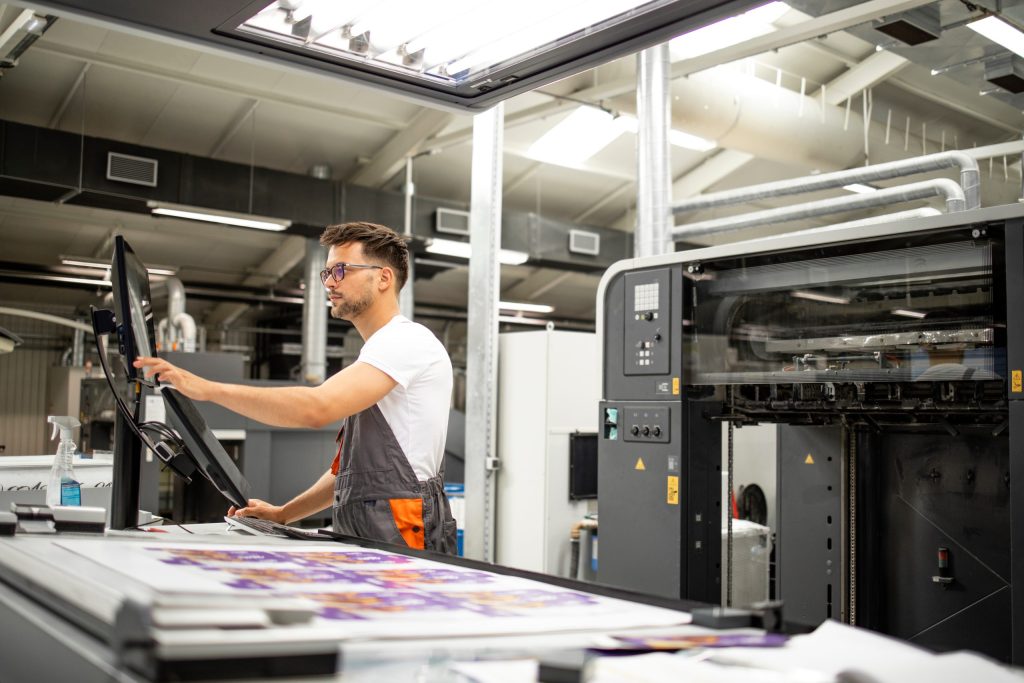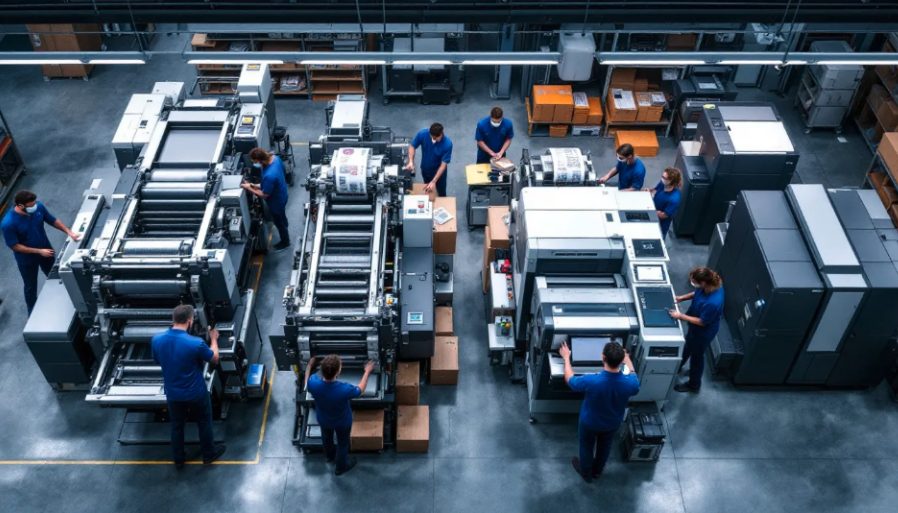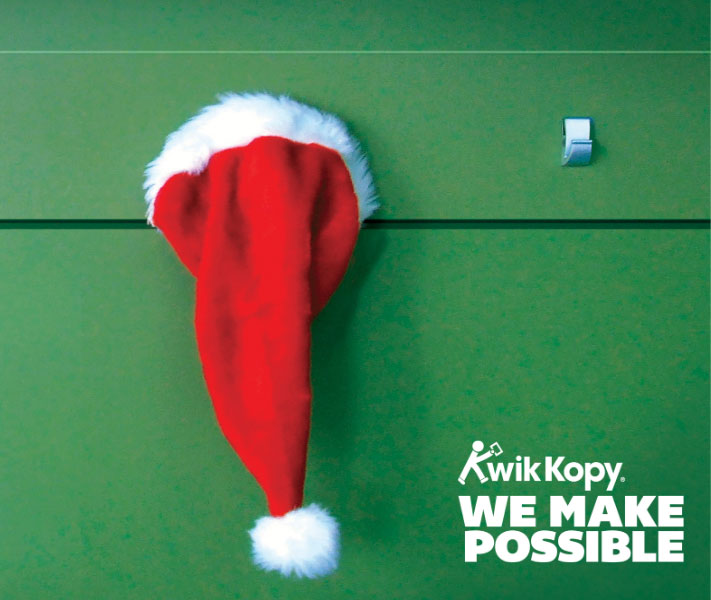
Deciding between offset and digital printing can make a significant difference in the quality, cost, and timing of your project. Each method brings its own strengths, and knowing which one suits your needs ensures you get the best results without wasting budget or time.
In this guide, we’ll walk you through the essentials – what each process involves, how they compare, and the situations where one shines over the other. We’ll also share practical tips and examples that show how the right choice can help you achieve a professional finish, stay on budget and meet your deadlines.
Whether you’re printing business cards, marketing collateral or preparing for a large commercial run, this overview will give you the clarity to choose with confidence.
Understanding Offset vs Digital Printing: How Do They Work?
Offset Printing
Offset printing is a finely tuned, mechanical process designed for consistency and precision. It starts with aluminium plates – one for each colour in your design. These plates are fitted onto the press, where they transfer ink to a rubber roller and blanket. From there, the blanket presses the ink onto the paper, giving you clean, accurate results every time. Because the image is transferred in stages, offset delivers the same crisp quality whether you’re printing hundreds or tens of thousands of copies.
Digital Printing
Digital printing takes your file and goes straight to press. Instead of using plates, the image is applied directly to the paper with either toner (like a laser printer) or liquid ink through high-end inkjet technology. These presses can place thousands of microscopic droplets in a fraction of a second, producing sharp results without the need for additional setup.
The key difference compared to offset is how the ink is applied. Offset transfers ink from plates via a roller system, whereas digital prints it directly from the file. That makes digital printing perfect for shorter runs, personalised projects and jobs where speed really matters.
Why Choosing Between Offset and Digital Printing Matters in Modern Business
Choosing between offset and digital printing can significantly impact your budget. Offset printing involves more upfront setup – such as creating plates and calibrating the press – but once it’s running, the cost per unit drops significantly for larger jobs. Digital printing has minimal setup, making it the better choice for smaller runs or projects that require quick turnaround.
Quality is another factor to consider. Offset is still the benchmark for precision, offering fine details, exact colour matching, and consistent results across thousands of copies. Digital printing, however, has come a long way. Today’s digital presses produce sharp, vibrant results that meet professional standards for most marketing materials and business needs. Offset remains the leader if your brand demands specialised colour reproduction or ultra-fine detail.
Timing can also make the decision clear. When deadlines are tight, digital printing offers same-day or next-day delivery in many cases. Offset takes longer to set up, but once everything is in place, it’s built for volume.
Offset vs Digital Printing Comparison Table
| Factor | Offset Printing | Digital Printing |
| Print Quality | Superior image quality, finest detail reproduction | High-quality output, excellent for most applications |
| Setup Costs | High | Minimal |
| Cost Per Unit | Low for large quantities | Higher per unit, cost-effective for small runs |
| Minimum Quantity | 500-1000+ for cost effectiveness | As low as 1 copy |
| Color Accuracy | Excellent Pantone matching, spot colours | Good colour reproduction, limited spot colour options |
| Turnaround Time | 3-10 days, including setup | Same day to 48 hours |
| Customization | Fixed content only | Full variable data printing capability |
| Paper Types | Extensive substrate options | Growing range, some limitations on specialty papers |
The break-even point typically occurs between 500 and 1000 units, where offset printing becomes more cost-effective than digital printing for standard projects.
Step-by-Step Guide to Choosing the Right Printing Method
Step 1: Assess Your Needs
Start with the basics: how many copies do you need, what level of quality is required, and how quickly do you need them? Digital printing is usually the best fit for short runs, quick turnarounds and everyday marketing materials. Offset comes into its own for larger volumes, precise colour matching and fine detail. Always weigh up the total cost, including setup, storage and potential reprints.
Step 2: Match to the Right Method
As a general rule, digital printing is ideal for jobs under 500–1000 units, while offset printing is more cost-effective for larger quantities. If you need personalisation or frequent changes, digital is the way to go. Offset is better when you want specialty print finishes, unique paper stocks or spot colours. Sustainability may also play a role, with digital creating less waste on small jobs and offset proving efficient at scale.
Step 3: Confirm and Optimise
If your project falls in the middle ground, get quotes for both methods. Request samples – ideally from your chosen stock – to verify quality. And think ahead: will you need reprints, larger runs or evolving designs? Factoring in scalability now can save you time and money later.

Common Mistakes to Avoid When Choosing Between Offset and Digital Printing
Choosing Digital for Large Runs Without Comparison
Many businesses select digital printing for convenience, but when quantities exceed 2000 units, offset printing can deliver major cost savings. Always calculate the total project cost, including setup, when volumes approach the break-even threshold.
Using Offset for Urgent Projects
Offset printing requires plate creation and setup, which can delay delivery. For urgent projects with tight deadlines, digital printing is often preferable even if the per-unit cost is higher.
Overlooking Variable Data Printing
Digital printing is the only option that supports full variable data. Direct mail campaigns, personalised marketing materials, or numbered certificates all rely on this capability to achieve impact and efficiency.
Pro Tip from Kwik Kopy
Always factor in total project costs, including design changes, storage and distribution timing. When your print run falls in the 500–1000 unit range, ask Kwik Kopy for samples and quotes on both digital and offset. Our team will help you make a data-driven decision that balances quality, timing and cost.
Key Takeaways for Choosing Between Offset and Digital Printing
Digital printing works best for short runs under 500 units, quick turnarounds, personalised projects and trial designs. Offset is the smarter choice for runs over 1000 units, where you need the highest quality, specialty inks and cost efficiency at scale.
Sometimes a mix of both delivers the best outcome – offset for sharp, consistent backgrounds and digital for personalised details.
If your job falls between 500 and 1000 units, Kwik Kopy can provide quotes and samples for both options so you can compare quality and cost with confidence.
With more than 40 years of experience and local centres across Australia, Kwik Kopy can guide you through the options, provide expert advice, and ensure you choose the right solution. Connect with your local Kwik Kopy centre to review paper stocks, samples and pricing, and let us help you achieve the best possible outcome for your print project.
Frequently Asked Questions
Offset offers the broadest range of papers, inks and finishes, including metallics and unique substrates. Digital presses are continually improving and now support a wide range of specialty stocks; however, some limitations persist with thicker or heavily textured papers.

